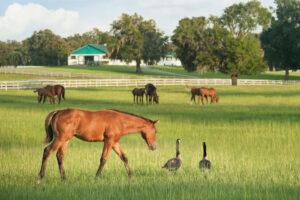New Tufts Veterinary Conference
The inaugural “Bridge to the Future” veterinary conference, hosted by Tufts University School of Veterinary Medicine, was held in Providence, RI, on Aug. 10-11. This year’s speakers included Mary Rose Paradis, DVM, MS, Dipl. ACVIM, associate professor of large animal medicine at Tufts, who spoke about geriatric horses and ponies. Paradis discussed the results of a recent study designed to
- Topics: Article
The inaugural “Bridge to the Future” veterinary conference, hosted by Tufts University School of Veterinary Medicine, was held in Providence, RI, on Aug. 10-11. This year’s speakers included Mary Rose Paradis, DVM, MS, Dipl. ACVIM, associate professor of large animal medicine at Tufts, who spoke about geriatric horses and ponies. Paradis discussed the results of a recent study designed to determine not only whether horses are living longer, but also what types of medical and surgical problems they face in their golden years.
The study found the number of horses over 20 years of age admitted to Tufts increased five-fold from 1989 to 1998, which might indicate that elder equines are receiving better medical care by owners who consider them a part of the family. Paradis noted that colic remains a major problem in older horses, particularly strangulating lipomas and large colon impactions. The latter is related to changes in digestive ability as well as increased dental problems. Older ponies which stop shedding in summer were also plentiful in the study. These animals often have pituitary disease, another problem of aging equines.
In discussing non-infectious airway disease of all ages of horses, Melissa R. Mazan, DVM, Dipl. ACVIM, director of equine sports medicine at Tufts, explained that while heaves (chronic obstructive pulmonary disease or COPD) is considered a late-stage illness, it is possible to catch an earlier stage called inflammatory airway disease or IAD, which is treatable and sometimes reversible. The most effective means of diagnosing IAD is bronchoalveolar lavage, which involves passing a tube down the horse’s trachea and into the bronchoalveolar junction to collect fluid. The procedure can be done at many veterinary clinics, and it has the potential to identify a very serious problem when it is still early enough to prevent it from progressing to COPD.
Carl A. Kirker-Head, VetMB, MRCVS, Dipl. ACVS, Dipl. ECVS, Marilyn M. Simpson Chair in Equine Medicine at Tufts, discussed the practicality and feasibility of standing fracture fixation for specific types of bone fractures in horses. Unfortunately, the cost of fracture repair in the operating room is sometimes beyond what the average horse owner can pay. However, standing fixation can provide a reasonable alternative for certain injuries. In fact, Kirker-Head explained that many failures of fracture repair occur in the recovery room
Create a free account with TheHorse.com to view this content.
TheHorse.com is home to thousands of free articles about horse health care. In order to access some of our exclusive free content, you must be signed into TheHorse.com.
Start your free account today!
Already have an account?
and continue reading.
Related Articles
Stay on top of the most recent Horse Health news with
















